Air conditioner with fresh air supply: design and selection of a supply air split system
In warm and comfortable houses often have problems with natural ventilation, and therefore the oxygen content drops sharply. This affects the health and activity of homeowners and workers.
To solve the problem, forced ventilation is used. A modern air conditioner with an influx of fresh air is an example of an efficient and affordable HVAC equipment. We will tell you how the equipment works and how to choose it wisely.
The content of the article:
Comparison of conventional and supply air conditioners
A common mistake among users is that they consider any air conditioning system ventilation. In fact, in the regime of active air exchange with street air masses, only certain types of equipment can work. To make it clearer, to begin with, we will consider the device of a conventional split system.
Air conditioners for domestic use, which are commonly called split systems, are a set of two separate modules having a different structure from each other and located in different places.
The first module is an evaporative block, which is installed on the floor, suspended on a wall or partially masked with a ceiling lining. The second module is a remote condensing unit, usually mounted on the facade of a building.
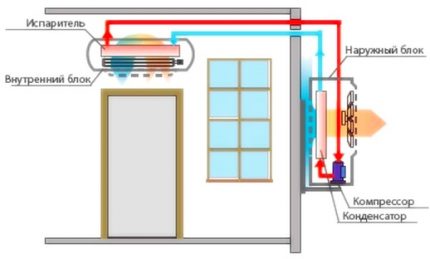
The principle of operation of the air conditioner is simple. Through the intake grilles, room air enters the inside of the unit, where it is cooled, and then discharged through the air ducts.The change in air temperature is not based on the production of cold, but on the transfer of thermal energy.
The carrier is freon, which enters the remote module in a gaseous state, and returns in liquid. To go into the gaseous phase, Freon takes part of the heat from the exhaust air in the evaporator.
In fact, no replacement of air masses occurs, and cooling (as well as heating and filtration) is carried out by recirculation. Supply equipment is arranged differently. An example of a split system with the organization of fresh air flow is a channel type device.
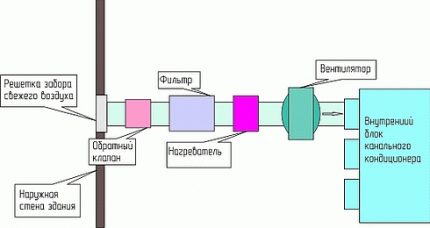
Of course, ordinary split systems are easy to install, have many additional functions, have a beautiful modern design, but they, unlike the supply ones, do not refresh the air in the room - and this is their main disadvantage.
What is the feature of multisplit systems?
Speaking about air conditioners in a general sense, it is necessary to mention multisplit systems, which are also used for the equipment of multi-room apartments, private houses, office and industrial buildings.
They differ from ordinary ones in that they have only one remote unit, while there may be several internal ones. The minimum number is two modules, the maximum is limited to four. If you use a larger number of indoor units, the system will lose its performance and will not work at full capacity.
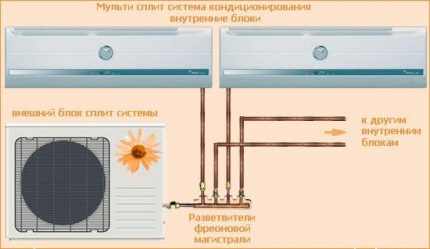
A multisplit system is not always used, but only in individual cases when the installation of a large number of outdoor units is not possible for a number of reasons:
- the building is a historical or architectural monument;
- there is a ban on the installation of remote units on the facade;
- for the hitching of equipment, the architecture of the building provides for certain places limited in area.
Sometimes they refuse to mount a large number of remote modules for aesthetic reasons: the beautiful facade of the building, hung with dimensional buildings, looks unpresentable.
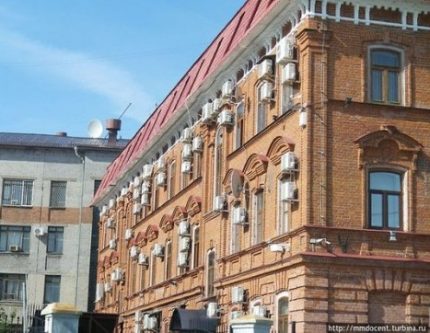
The advantage of the multisystem is the installation of one remote module, the disadvantages are the complex work on the installation of pipelines, reduced productivity and reliability. In addition, all indoor modules must operate in identical modes: either for heating or for cooling.
Supply duct models
The function of replacing exhaust air masses with air from the street is fully realized only with ducted air conditioners, so we will analyze their features and operational characteristics in more detail.
Well-designed and installed channel split-system copes with the tasks of ventilation, and with control over the indoor climate.
Distinctive features of the air conditioner with inflow
The recirculation models of ducted air conditioners (CC) are similar in principle to conventional split systems, but they differ in design and installation location. Indoor modules are built into suspended ceiling structures, and air circulates through the channels connecting them to the outdoor unit.
It looks like a simple recirculation model, not able to supply fresh air. In order for the system to perform the supply function, a built-in heater is required. This is regulated by the rules of SNiP, according to which the lower temperature threshold of the air masses coming from the street should be +14 ° С.
If the outdoor temperature is above -15 ° C, it copes with the heating function Heat pump. However, at lower temperatures, air conditioning models with water or electric heaters are used. The equipment that carries out the heating can be either additionally installed or built-in.
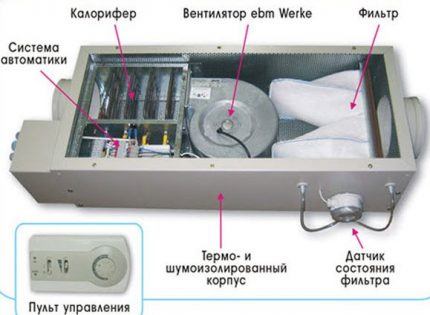
Programmable supply systems are more expensive than conventional room modifications with a wall-mounted installation, but they are much more efficient and more functional thanks to the combination of ventilation and air conditioning. The amount of oxygen in the air meets sanitary requirements, the temperature is easily regulated, and the appearance does not create discomfort, since all working parts of the system are in an invisible zone, above the ceiling.
The principle of the supply system
To transport air from the street to the premises, air ducts are provided, which are not available in conventional split systems. First, the air from the street through the outdoor unit moves to the insulated channel, then to the mixing chamber. There, the incoming air is connected to the exhaust, refreshing it.
Then the air mixture passes through the filters and, according to the selected mode, is processed. Draining, heating or cooling of the air mass occurs. After that, purified, filtered, partially refreshed air of a given temperature enters the premises.

As a rule, the maintained temperature is completely dependent on the season. In the summer, the supply air duct air conditioners work for cooling, in the winter for heating. In the cool season, the functioning of the heat pump is sufficient, the heater can not be used during this period.
Types of equipment with a mixture
As you already understood, only duct equipment with air ducts and heating can fully cope with the replacement of fresh air. However, some other types of models can also provide ventilation, but within 10% of their performance.
The fraction of fresh air is often referred to as a “mix”, the main part of the air mass is occupied by the “exhaust” processed in the indoor unit.
Traditional wall patterns
Models, the indoor unit of which is mounted on the wall, are the most popular for the improvement of residential premises.
There are models that provide a comfortable microclimate on an area of 10 m², but there is more powerful equipment designed for rooms up to 100 m². Not so long ago, inverter models appeared, equipped with a supply and exhaust fan.
Regardless of whether the air conditioner is operating in heating or cooling mode, the supply and exhaust system can operate in parallel. An example of a wall-mounted device with outdoor air supply is the Air Exchanger range of the renowned HITACHI brand.
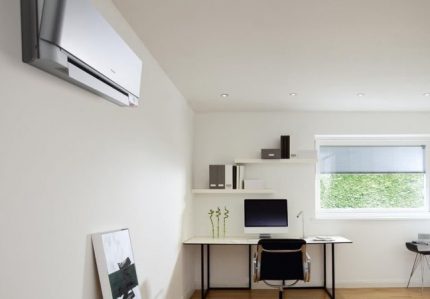
A wall mounted evaporator unit is installed anywhere in the room, but the area near the window is preferred. The shorter the line between the indoor and outdoor units, the higher the productivity of the equipment. Wall-mounted models are distinguished by a pleasant design and a wide range of additional options.
Cassette air conditioning
Often in public buildings you can find air conditioning with internal cassette-type modules. Such systems are suitable for servicing large areas - from 40 m² to 150 m². They have high performance and are favorably distinguished by minimal noise indicators.
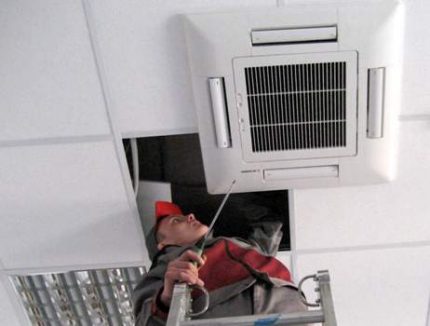
The performance of cassette air conditioners is from 3 kW to 15 kW, the main functions are lowering the temperature in the room or working in the heat pump mode.
A design is widespread in which the air is taken from the hall through the central hole, and the air is fed in four guides in different directions. If one cassette is used, then it is mounted in a suspended structure in the center of the room.
On the market you can find both traditional modifications and mixed cassette systems. For example, Airwell CK air conditioners are designed for the installation of multi-split systems and, thanks to the built-in heater and air ducts, carry out a dosed supply of fresh air.
Advantages - beautiful design and high performance, disadvantage - installation only in a suspended structure.
Floor and ceiling devices
In some rooms there are no conditions for the installation of cassette models, and the performance of wall-mounted air conditioners is not enough. In this case, universal floor-and-ceiling devices are used, which have mounts both for installation on the floor and for hanging from the ceiling.
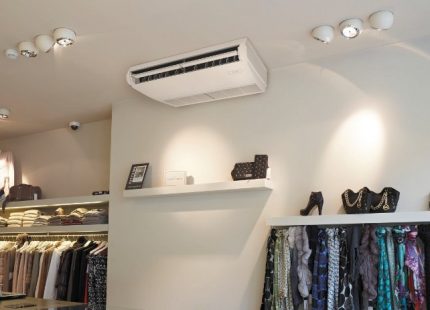
Air conditioning is provided by a stream of purified air, which is directed along the ceiling or wall - depending on the installation location. The highest power of the devices is 15 kW, but for relatively small rooms (40 m²), equipment with parameters of 5-6 kW is enough.
Columned models of split systems
As the name suggests, air conditioners in their shape resemble columns directed to the ceiling. They surpass other types in terms of power (17 kW on average) and can serve rooms of up to 180 m².
The principle of operation of the column type models is the same as that of the previous air conditioners, however they differ in the supply of purified air. The jet is directed not along the walls and not in the center of the room, but towards the ceiling. There, the cooled air diverges in different directions and falls, displacing the already heated.
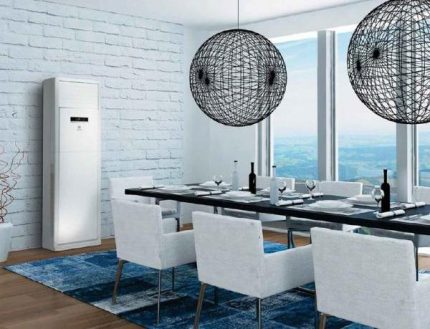
Partial recirculation models of pure air have high performance, but their noise level is higher than that of steel types - up to 50 dB.
The benefits of multi-zone air conditioning
Multi-zone room service is a more advanced version of multi-split systems that creates a certain microclimate over a large area. The fundamental difference from standard split systems - the increased length of the highways connecting the modules located in various places.
Advantages of the multizone system:
- up to 20 internal ones can be connected to 1 remote unit;
- the distance from the internal module to the external - up to 150 m (in some cases - more);
- the height difference between the modules is 50 m.
Thanks to these parameters, the outdoor remote module is installed in the most convenient remote places - in the attic, roof, in the yard behind the fence, etc.
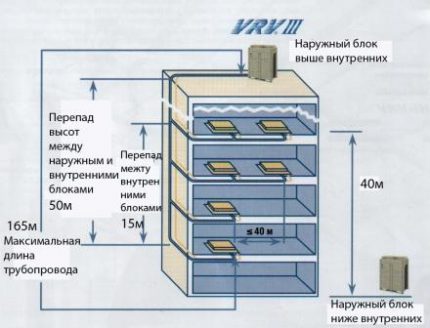
The multizone system is more economical because the control invert climate equipment allows you to change the power of the system depending on the number of functioning indoor units.
In this case, you can use absolutely different type and performance modules. Adjustment and control over the operation of all equipment can be done in system mode, from one remote control.
You can read the conventional and inverted climate control and get an idea of their pros and cons by reading The article we proposed. Before making a decisive choice, you should familiarize yourself with useful information.
Tips for choosing air conditioners
Before purchasing a split system for home use or for office use, it is first necessary to decide whether ventilation is needed. Perhaps the room is equipped with an effective ventilation system and does not need additional devices of this type.
If air exchange is weak, pay attention to the supply air conditioner models.
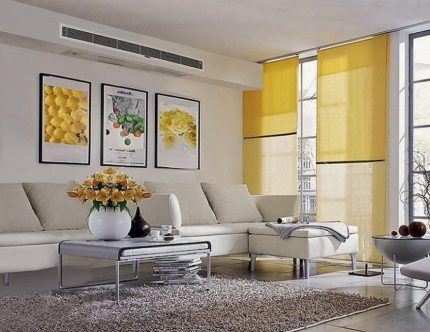
If the ceilings are low (for example, 2.5 m), the idea with ceiling models will not work. Perhaps, according to the technical characteristics, you can pick up a device with a wall module that simultaneously mixes air from the street.
For larger rooms, a more productive model, for example, with a floor-and-ceiling installation, will be required. The halls of the hotels, the lobby and the lobby are large. In addition to channel systems, column models are installed in them, characterized by productivity and high air exchange rate.
Regardless of the type of device, it is necessary to analyze its technical characteristics and operational qualities: to clarify what area the model is designed for, what is its power, is it possible to connect additional modules.
The latest programmable air conditioners with a large list of additional options are much more expensive, however, some functions are indeed important.
With guidelines for choosing a split system for arranging a country house and city apartment next articlecontaining information with answers to questions from potential buyers.
Conclusions and useful video on the topic
In order to better understand the device and the principle of functioning of supply split systems, we offer you to watch videos of an overview nature.
Video # 1. Overview of Haier duct air conditioners:
Video # 2. About the advantages of channel type models:
Video # 3. More about multizone systems:
To enrich the air in the room with oxygen, it is not necessary to keep the window open or install additional ventilation. Sometimes it’s enough to correctly select the model of the air conditioner, which, if necessary, will not only cool / warm the room, but also carry out air exchange.
Please write comments in the block below.Perhaps you are aware of the nuances not mentioned in the article of the choice and installation of air conditioners that provide fresh air. Ask questions, share useful information and your own opinion, publish thematic photos.

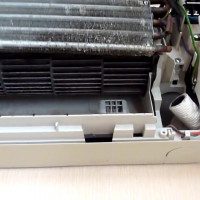 The device of the indoor unit split system: how to disassemble equipment for cleaning and repair
The device of the indoor unit split system: how to disassemble equipment for cleaning and repair 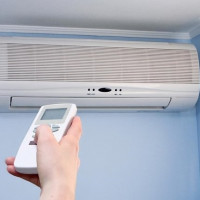 Air conditioning and split system - what is the difference? Differences and selection criteria for climate technology
Air conditioning and split system - what is the difference? Differences and selection criteria for climate technology 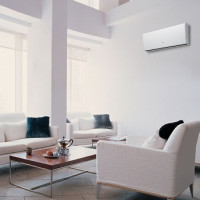 Air conditioning or split system - which is better? Comparative review
Air conditioning or split system - which is better? Comparative review 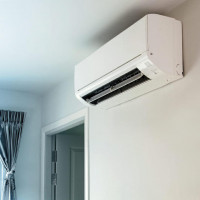 What is a split system: device and principle of operation of typical air conditioning systems
What is a split system: device and principle of operation of typical air conditioning systems  Where can I put air conditioning: the choice of the optimal place for installation in a private house and apartment
Where can I put air conditioning: the choice of the optimal place for installation in a private house and apartment  Proper use of split systems: operation of equipment + tips for care
Proper use of split systems: operation of equipment + tips for care  How much does it cost to connect gas to a private house: the price of organizing gas supply
How much does it cost to connect gas to a private house: the price of organizing gas supply  The best washing machines with dryer: model rating and customer tips
The best washing machines with dryer: model rating and customer tips  What is the color temperature of light and the nuances of choosing the temperature of the lamps to suit your needs
What is the color temperature of light and the nuances of choosing the temperature of the lamps to suit your needs  Replacement of a geyser in an apartment: replacement paperwork + basic norms and requirements
Replacement of a geyser in an apartment: replacement paperwork + basic norms and requirements
There is some kind of trouble with split systems, the market is flooded with cheap Chinese counterfeit goods. Our masters did not have time to travel to different offices in the summer and accept requests for repairs. As soon as a little more than 25 degrees on the street - they immediately begin to break. And at the offices, they don’t understand split systems, they bought everything the cheapest on the market, and they want it to be cool and everything works, but it doesn’t happen, you have to pay for everything.
The market, Vasily, is formed not by suppliers, but by buyers. In other words, what ordinary people buy, sellers buy. Russians do not have enough money for reliable split systems, and offices buy air conditioners through tenders. There is only one criterion - the supplier with the lowest cost wins.
Just now, we are choosing an air conditioner for the home, as the bedroom windows are on the sunny side, in the summer it is simply impossible to be in the room, it is very hot. I had no idea that there are columned models of air conditioners! Its principle of operation and cooling of the room impresses me much more than that of the ceiling ones. Moreover, the ceilings in our house are low, so there are no options here - we will consider columned models.
I do not trust these supply air conditioners. The inflow is carried out through a thin tube and gives out a maximum of 60 m3 / hour, and this is the norm for only one person. Despite the fact that the prices for these devices are high.
You surprised me, Alex, with the realization of the phenomenon "flew into one ear, flew out of the other." After all, the whole section describes the operation of channel systems - there are no tiny tubes there. And some conventional split systems, the author constantly reminds, can provide no more than 10% of the fresh air flow - an honest warning that does not involve advertising.